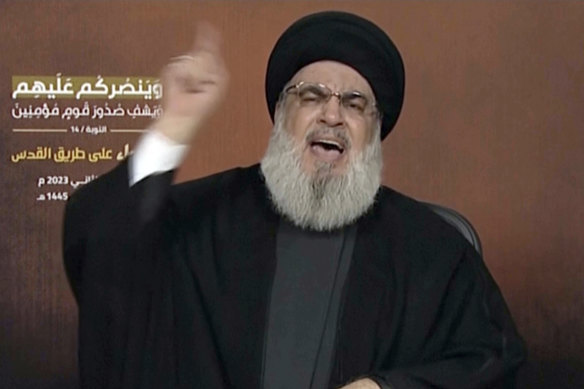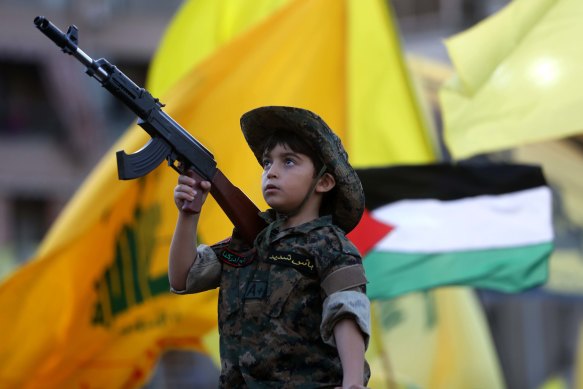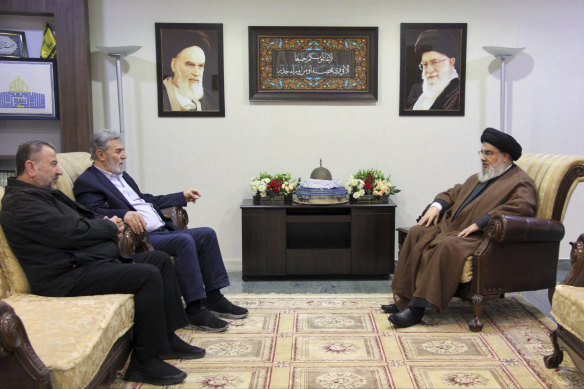‘Messianic figure’: Who is Hasan Nasrallah, the leader of Hezbollah?
By Bryan Pietsch
Hassan Nasrallah, the head of Hezbollah, an Iranian-backed militant group with widespread political influence in Lebanon, gave his first address on Friday since the October 7 Hamas attack on Israel.
If Hezbollah, a proscribed terrorist group in Australia, the US and UK among others, were to escalate attacks along Israel’s northern border in response to Israel’s military offensive in the Gaza Strip, the war could spiral into a regional conflict. Nasrallah did not announce a change in policy but said all options remained “on the table”.

This video grab shows Hezbollah leader Sayyed Hassan Nasrallah speaking via a video link, during a rally in Beirut, on Friday.Credit: Al Manar TV/ AP
Here is what to know about Nasrallah’s role in Hezbollah and his views on the Israel-Gaza war.
Who is Hassan Nasrallah?
Sayyed Hassan Nasrallah was born in Beirut in 1960. He studied to become a cleric at Shiite seminaries in Iran and Iraq.
He reportedly joined Hezbollah in the early 1980s, following the Israeli invasion of Lebanon in 1982 and became the leader of the group in 1992 after the assassination of his predecessor, Sayyad Abbas Musawi, by Israeli forces.
Nasrallah, 63, led Hezbollah for the latter half of the Israeli occupation of Lebanon, which lasted formally for 15 years at the end of the 20th century.
Though he is not technically a public official in Lebanon, Nasrallah is one of the country’s largest-looming political figures. Hezbollah and its allies lost the majority in last year’s parliamentary elections but still hold the largest share of seats, in a time of economic crisis and widespread discontent.
Nasrallah is known for his long, bombastic speeches and a pronounced lisp. His followers call him “The Sayyed” or “Abu Hadi” which is Arabic for Father of Hadi, his son, who was killed in clashes with Israeli troops in 1997.
One of his most triumphant moments was during the month-long war that Hezbollah militants and Israel waged in 2006. Three days into the conflict, he was speaking on air with Hezbollah’s Al Manar channel and said the surprises he had promised were about to begin. An Israeli warship was then targeted.
“Watch it burn,” he said.

A young boy among supporters of Hezbollah gathered in Beirut to hear Hassan Nasrallah’s speech on Friday.Credit: Getty
Walid Phares, a Lebanese-born political commentator, told the Council on Foreign Relations in 2010 that Nasrallah was seen among some in Lebanon as a “messianic figure”.
In a 2006 dispatch from Lebanon, Robin Wright, then a Washington Post reporter who visited the leader in Beirut, wrote that Nasrallah’s face was displayed there on computer screen savers, posters and keychains. “Taxis play his speeches instead of music,” Wright reported.
What are his views?
A key goal of Hezbollah, according to its 1985 manifesto, is the destruction of Israel. Under Nasrallah, Hezbollah has continued to engage in skirmishes with the Jewish state.
Though Hamas is Sunni and Hezbollah is Shiite, and the two militant groups have disagreed on other conflicts in the region, they have found common cause recently in opposing Israel; destroying Israel is also a stated aim of Hamas, also a proscribed terrorist group. Both receive support from Iran, experts and officials say.
The Israeli occupation of Lebanon appears to have been formative in Nasrallah’s motivations. He told Wright in 2006 that he and his peers had witnessed “what happened in Palestine, in the West Bank, in the Gaza Strip, in the Golan [Heights], in Sinai”.
That taught him that in Lebanon, “we cannot rely on the Arab League states, nor on the United Nations,” he said. “The only way that we have is to take up arms and fight the occupation forces.”
What has Nasrallah said about the Israel-Gaza war?
Since the conflict began October 7, when Hamas attacked Israel, Hezbollah and Israel have traded fire near the Israel-Lebanon border. Yet, the extent to which Hezbollah will become involved in the war between Hamas and Israel remains unclear, amid fears of wider regional escalation.

Hezbollah leader Hassan Nasrallah, right, with Ziad al-Nakhleh, head of Palestinian Islamic Jihad, centre, and Hamas deputy chief, Saleh al-Arouri, in Beirut, Lebanon on October 25. On the wall: founder of the Islamic Republic of Iran Ayatollah Khomeini, left, and current supreme leader Ali Khamenei.Credit: AP
Nasrallah made his first public remarks on the matter in an address on Friday, saying that Hezbollah and other Hamas allies were unaware of the plans for the October 7 attack, but that Hamas had “no other choice” but to attack Israel. “The other choice,” he said, “would have been silence and death”.
In his speech, Nasrallah boasted that Hezbollah’s “daily, targeted” strikes against Israel were distracting and weakening it in its fight against Hamas. He warned Israel against any “aggression or preemptive strike” on Lebanon, which he said would be “the biggest idiocy in the history of your existence”.
Hezbollah’s fighting with Israel on the border, he said, “is a front of solidarity and support for Gaza”.
That front is evolving based on developments in Gaza, he said, adding that “all the options are on the table and we could go toward them at any point in time.”
Sarah Dadouch, Ellen Francis, Justine McDaniel, Mohamad El Chamaa and Frances Vinall contributed to this report.
The Washington Post
More coverage of the Hamas-Israel conflict
- Cascading violence: Tremors from the Hamas attacks and Israel’s response have reached far beyond the border. But what would all-out war in the Middle East look like?
- The human cost: Hamas’ massacre in Israel has traumatised – and hardened – survivors. And in Gaza, neighbourhoods have become ghost cities.
- “Hamas metro”: Inside the labyrinthine network of underground tunnels, which the Palestinian militant group has commanded beneath war-ravaged Gaza for 16 years. The covert corridors have long provided essential channels for the movement of weapons and armed combatants.
- What is Hezbollah?: As fears of the conflict expanding beyond Israel and Hamas steadily rise, all eyes are on the militant group and political party that controls southern Lebanon and has been designated internationally as a terrorist group. How did it form and what does Iran have to do with it?
Most Viewed in World
>read more at © Sydney Morning Herald
Views: 2